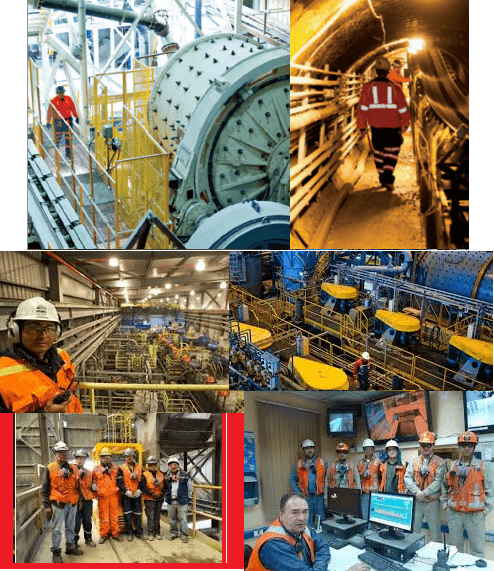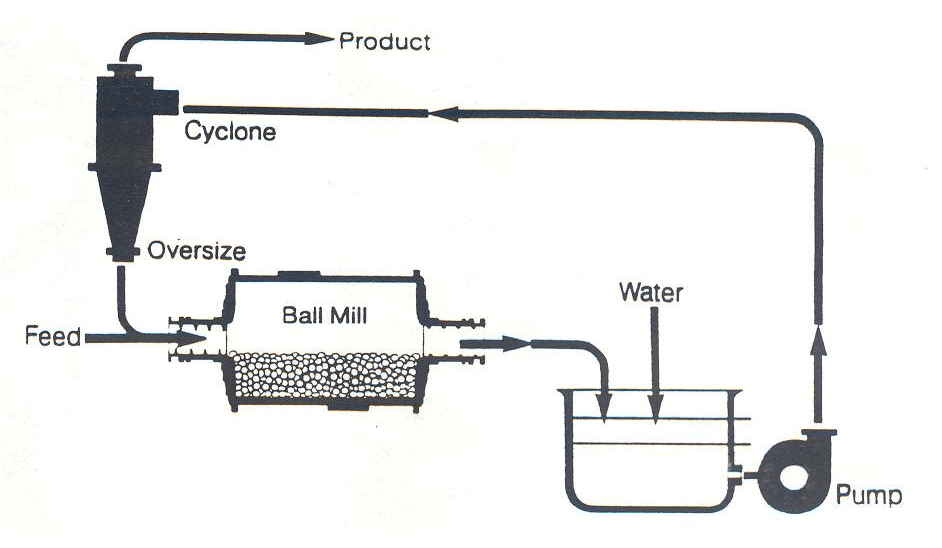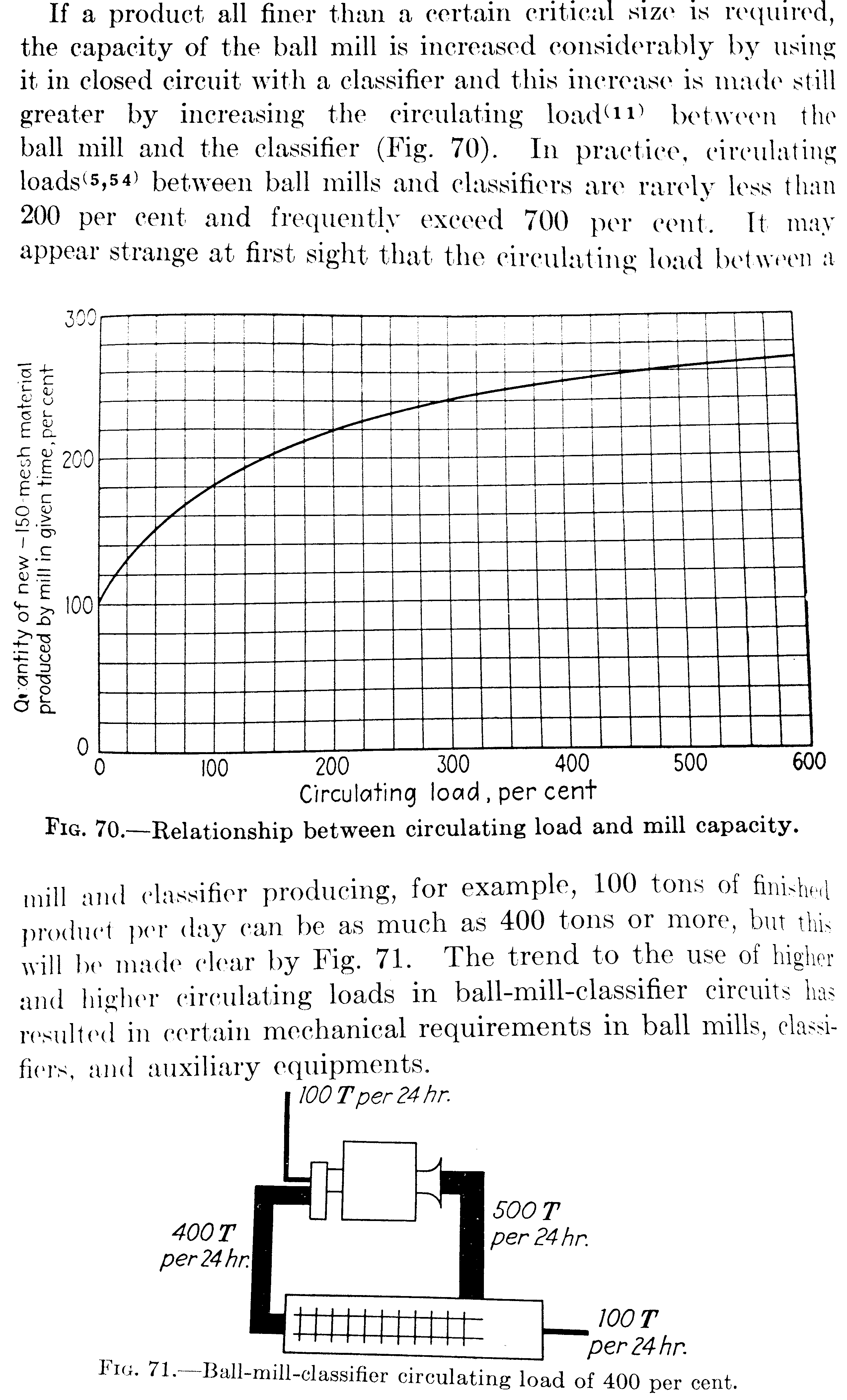 In the operation of a grinding circuit you are managing several pieces of equipment as a single unit. If you make a change in the ore in the fine ore bin, that change will be reflected through the entire grinding process and beyond into the rest of the concentration system.
In the operation of a grinding circuit you are managing several pieces of equipment as a single unit. If you make a change in the ore in the fine ore bin, that change will be reflected through the entire grinding process and beyond into the rest of the concentration system.
The first thing that an operator will have to learn is to be able to tell when the rod mill is, or isn’t, grinding fine enough. With a little practice the operator will be able to simply look at the discharge of a rod mill and determine how well it is working. The variables that are being looked at are color and consistency of the slurry. If the rock is staying in suspension or is it classifying as it slides over the discharge trunnion? The amount of rejects that are being discharged. And the manner in which the slurry is beading on the side of the discharge trunnion as it is flowing across it. These will give an indication of any change in the density or the ore. To verify any change that you think that you see in the discharge, simply take a density. If it has changed then so has your circuit. Once you have finished weighing the density sample, pour it out over your gloved hand, you will be able to feel and see the difference in the grind.
Let’s pretend that you have taken all of your densities, checked the grind and the number of rejects that are coming out of the mill. Prom this information you have decided that the circuit could use some more tonnage. So you go to your control panel and increase the through put, oh, ten tons per hour. What happens to your circuit? First the extra ore enters the rod mill the density begins to climb and the grind gets coarser. You start to get a few rejects. Then the heavier density with the courser grind is pumped to the cyclone. Both the overflow and the underflow from the cyclone become heavier. Remember you now have a higher amount of ore that will have to be ground further. This causes the density of the ball mill to climb. Which in turn is discharged back to the cyclone. If now, you go back through the circuit, and check your variables you will notice that the rod mill density has increased. The grind has gotten worse. The cyclone over flow density and the ball mill density has gotten heavier.
You think that the rod mill grind could be better, after all, the density is above the recommended range that your supervisor wants it run at. So you add a little water. The water decreases the retention time. It also improves the grinding action of the rods. The higher density was cushioning the rods. The movement in the core area of the rod load had been restricted due to the excess tonnage. Increasing the water improved the rate of fine material discharge. Maintaining the correct density will insure that the rate of discharge is correct. The lighter density may produce less coarse and marginally less fines but it will produce more of the middle sizes.
 This size is called MIDDLINGS, which will have a large percentage of ore fine enough to be sent to the next stage of concentration. The water has caused both the amount of fines and the amount of coarse produced to drop. The amount of the middling sizes increased. The cyclone overflow would allow a lot of this middling size to escape the grinding circuit. This would decrease the amount of material that the ball mill would have to grind. Which in turn would lower the amount of ground ore returned to the cyclone for reclassification. This again would lower the resulting ball mill load even further.
This size is called MIDDLINGS, which will have a large percentage of ore fine enough to be sent to the next stage of concentration. The water has caused both the amount of fines and the amount of coarse produced to drop. The amount of the middling sizes increased. The cyclone overflow would allow a lot of this middling size to escape the grinding circuit. This would decrease the amount of material that the ball mill would have to grind. Which in turn would lower the amount of ground ore returned to the cyclone for reclassification. This again would lower the resulting ball mill load even further.
Although the cyclone overflow density may not change for a short period of time due to the extra water and the extra ore in the over flow more or less balancing each other out. It will as the decreased density of the underflow changes the grind of the ball mill. The density of the cyclone overflow will still be too high, but it has dropped a little from what it was. At this point, as the finished product, this is the MOST IMPORTANT DENSITY. To bring the density back to the operating perimeters, you add water going to the cyclone feed pump box. This will compensate for the higher density. Again there will be a reaction to the water in the underflow of the cyclone, but it will be a minor one, and a simple check of the overflow after a period of time will determine if any more adjustments are necessary. The other worry that the operator will have is the capacity of his circuit.
The maximum tonnage that can be processed will depend upon the capacity of the smallest piece of equipment that must handle the volume. This is another characteristic of each individual grinding circuit. It may be the rod mill that can’t take the load, or perhaps the cyclone or pump box. Whatever it is, you may he guaranteed that one piece of equipment will reach its limit before any of the others. That will be the one that you will watch the most.
The reaction of our fictitious circuit is, by no means, meant to be taken as a standard reaction to the different variables. How the ore will behave in the mill will depend upon the grinding characteristics of each individual ore body.
The purpose of this exercise was to illustrate the DYNAMICS OF A CIRCUIT. How a change in one portion of the mill will affect the rest of the circuit. It was also to show that it is possible for an operator’ to get into trouble if he doesn’t allow enough time for a change to completely go through the circuit before making another change. Checking the results of a change to soon can also lead to trouble. An example of this would be in the rod mill. If the operator had checked the rod mill load prior to the time it took for the extra volume of ore to fill up the mill, he could possibly feel that the resulting density was still within the perimeters set down by the supervisor. When in fact they hadn’t finished climbing yet. The results could be an overloaded grinding circuit, and a very poor grind.
When a circuit becomes overloaded it is because the amount of ore that is going out of the overflow is less than the total volume of the ore coming into the circuit. What is known as a CIRCULATING LOAD builds up. This is the ore that is going to the classifier, back to the ball mill, back to the classifier, back to the mill again. The work index and the size of the cyclone feed will determine the ratio of ore that is returned to the ball mill for further grinding. A ball mill operates more with the grinding surface action of the balls than the impact form of grinding that the rod mill uses. Taking this into account you can see that if the rod mill doesn’t reduce the ore to a size that the ball mill can reduce quickly, the circuit load will climb until its volume is greater than can be handled.
To maintain the maximum amount of through put that the grinding mills can handle it is necessary to keep what is termed as the “MEDIA RUNNING LOAD” to its maximum. This is the amount of grinding rods or balls that are in the mills. As the mills tumble and turn the grinding media wears away until the mill charge is too low to maintain the grind. The solution to this problem is to add more media. In the case of the rod mill the circuit will have to be shut down to accomplish this, the ball mill, however may have its media added while it is running. The standard method used to put the balls into the mill is to drop them into the feed end along with the feed. The rod mill will have a set of rollers put into the discharge end of the mill. The rods are then rolled in on top of these rollers to be dropped off onto the existing rod load. To know when to charge the mills you have to consult the “RUNNING LOAD” of the mill. This is simply the amperage load that the motor is working against. Every electric motor has a maximum amperage point, after which it kicks out. The running load is the percentage of the maximum amperage load that the electric motor can safely handle.
The grinding circuit is the most expensive circuit in the concentrator plant to run. To make the most profit from this equipment, it is necessary that it is run at the maximum amount of tonnage that the mills will handle. While maintaining the efficiency level that is set by management. There are times when it may seem that if you drop the tonnage five tons per hour you would save yourself a lot of work. The increased effectiveness would out-weight the lost tonnage. Most operators reason that the ore will not go away and it will still be here to be processed tomorrow. Unfortunately all of the mines finances will be set up on set of perimeters that have to be met. The farther that you can exceed them the bigger the safety margin you can have for emergency shut downs and unexpected expenses. That extra five tons per hour may be the gravy money. How the operator does his job goes a long way in the operation of a successful mine. There has been more than one mine that has been shut down by poor operating practices. It is the operator’s job to get every ton that he can out of his equipment. Keep down time to minimum. And to recover as much of the mineral as he or she can.
Before we get to a few of the safety aspects of grinding, I would like to REVIEW some areas of concern for the operator when CIRCUIT CHECKS are being done. Let’s start at the feeders. Here the operator must watch for ore stoppages. Foreign objects in the feed that could damage belts, or block transfer chutes. With these chutes come lost and worn liners and ore blockages. The conveyors have to be watched for belt wander and mechanical damage and weightometer be kept clean.
With the mill themselves, the trunnion bearing oil ring has to be watched. Leaking liner bolts and other wear caused by the abrasion of the ore has to be reported or fixed. Bull gears and some types of bearings have to be lubricated. Running loads monitored, as well as the other standard readings that are required. And last but not least maintaining good housekeeping standards.
Arthur Taggart

